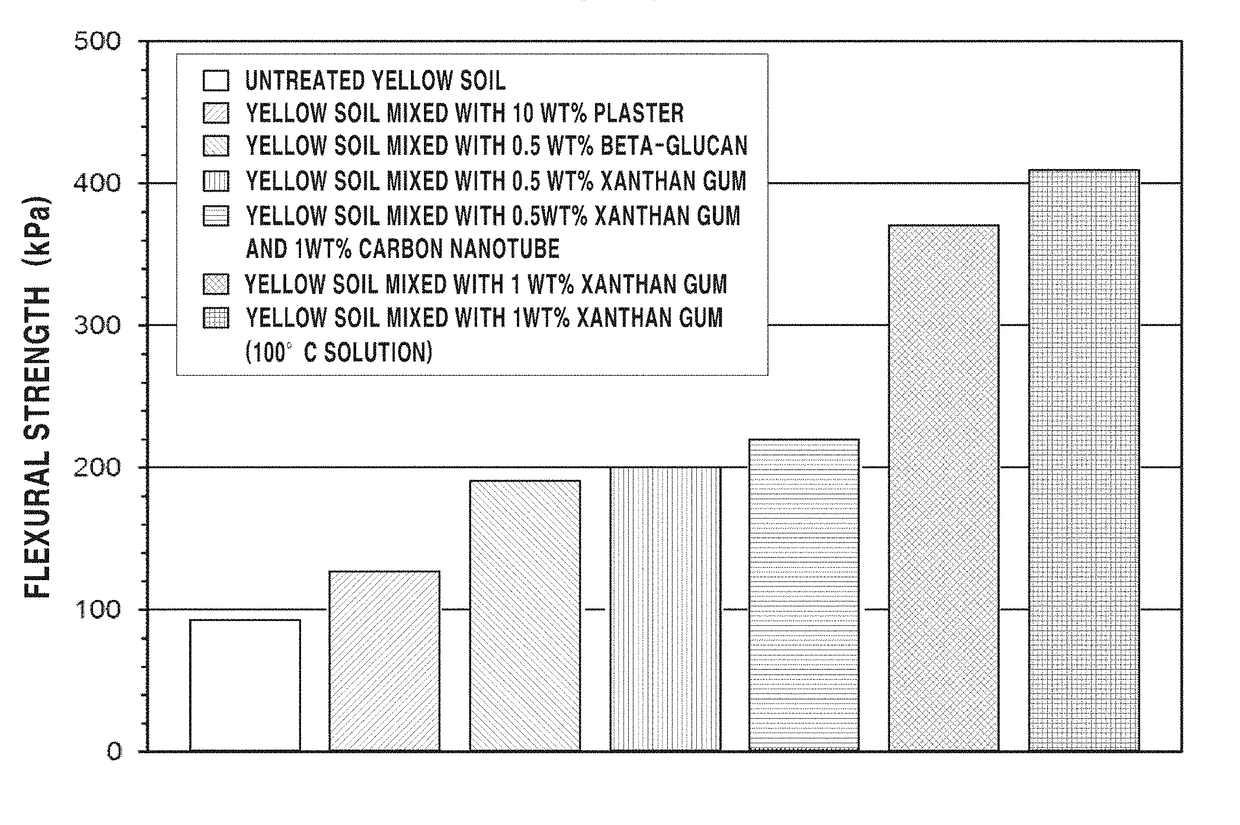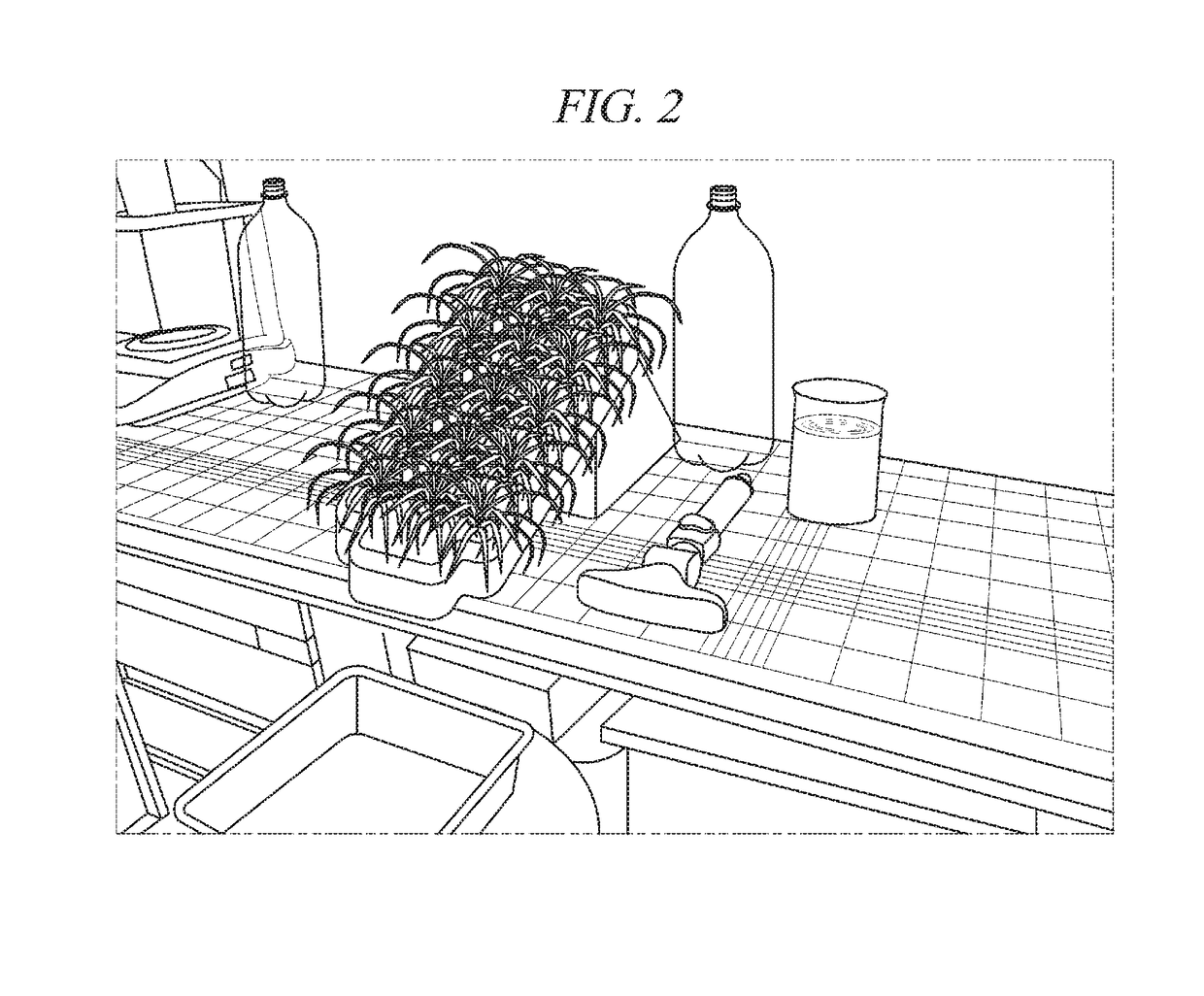Soil stabilization and improvement method using biopolymer
a biopolymer and soil stabilization technology, applied in excavations, agriculture, construction, etc., can solve the problems of many limitations of external mounted structures, inappropriate vegetation growth, etc., and achieve the effects of improving soil strength, improving soil erosion resistance, and increasing the binding strength (adhesion strength) of soil particles
- Summary
- Abstract
- Description
- Claims
- Application Information
AI Technical Summary
Benefits of technology
Problems solved by technology
Method used
Image
Examples
example 1
ion Resistance Measurement Using the Biopolymer
[0171]Various indoor experiments for verifying the soil erosion suppression effect of the biopolymer were conducted. In this Example, a beta-1,3 / 1,6-glucan-based liquid product (8.9 g / L of a beta glucan content; Glucan Corporation) was used as the high-molecular chain biopolymer material.
[0172]As the gelled polymer, xanthan gum (Sigma-Aldrich; CAS 1138-66-2) in the pure powder state, which is widely used as a food curing agent, was used in this Example. The most significant property of the xanthan gum is stability in various temperature and pH conditions.
[0173]With respect to the basic method for carrying out the invention, a soil was mixed with the corresponding biopolymer, and then, a rainfall condition was reproduced to measure an amount of soil loss in each case and evaluate the resistance against general soil erosion. Specific descriptions in this regard are provided below.
[0174]1. Erosion Resistance of the Biopolymer-Treated Soil ...
example 2
n Promotion Effect Measurement Using the Biopolymer
[0189]In this Example, various indoor experiments were conducted to verify the vegetation promotion effect of the biopolymer. In this Example, a beta-1,3 / 1,6-glucan-based liquid product (Glucan Corporation) was used as the high-molecular chain biopolymer material. In addition, as the gelled polymer, xanthan gum (Sigma-Aldrich; CAS 1138-66-2) in the pure powder state, which is widely used as a food curing agent, was used in this Example.
[0190]With respect to the basic method for carrying out the invention, a soil was mixed with the corresponding biopolymer, and then, crops were sown and cultivated under a constant temperature and humidity condition to identify germination and growth of the seeds, and furthermore, the structure of the soil was analyzed to determine how the biopolymer-treated soil affect growth of plants. Specific descriptions in this regard are provided below.
[0191]1. Seed Germination in the Biopolymer-Treated Soil
[01...
example 3
cular Viscous Gelled Polysaccharide Biopolymer-Soil Mixture Using Heat Treatment
[0209]In order to mix the high-molecular viscous gelled biopolymer and a soil with each other by using thermal gelation, irrespective of a type of the soil, a high-molecular viscous gelled polysaccharide biopolymer aqueous solution in the high temperature state and a soil were prepared. After the biopolymer in the powder state was dissolved in a solvent (water) having a high temperature (80° C.), the suspension was mixed with a heated soil to prevent premature gelation resulting from rapid temperature decrease upon the mixing. What is important in forming the hyperthermal biopolymer aqueous solution is that a concentration (a solute amount to the solvent) should be properly adjusted. In general, agar absorbs water corresponding to 20 times its mass at a room temperature due to its hydrophilicity, and the solubility increases with increase of the temperature. It is preferable to compose the hyperthermal s...
PUM
| Property | Measurement | Unit |
|---|---|---|
| molecular weight | aaaaa | aaaaa |
| temperature | aaaaa | aaaaa |
| temperature | aaaaa | aaaaa |
Abstract
Description
Claims
Application Information
 Login to View More
Login to View More - R&D
- Intellectual Property
- Life Sciences
- Materials
- Tech Scout
- Unparalleled Data Quality
- Higher Quality Content
- 60% Fewer Hallucinations
Browse by: Latest US Patents, China's latest patents, Technical Efficacy Thesaurus, Application Domain, Technology Topic, Popular Technical Reports.
© 2025 PatSnap. All rights reserved.Legal|Privacy policy|Modern Slavery Act Transparency Statement|Sitemap|About US| Contact US: help@patsnap.com



